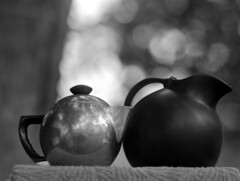Bokeh

|
| Smooth and unobtrusive bokeh (Kodak Anastigmat barrel lens) image by Voxphoto (Image rights) |

|
| Distracting ring bokeh from a mirror telephoto lens image by Uwe Kulick (Image rights) |
Bokeh (Japanese "boke" = blur or haze) is how a lens renders unsharp image areas. The effect becomes notable when the unsharp background (or foreground) has significant contrasts, especially when small light points appear against darker surroundings. Portraiture particularly calls for lenses with a pleasant or soft, undisturbing bokeh.
Defocused points of light will show the shape of the the aperture opening, and this can be distracting when it is noticeably hexagonal or octagonal. However simply redesigning a diaphragm to provide more a rounder opening does not guarantee pleasing bokeh.[1] Other factors such as the degree of spherical aberration affect how light is distributed within the blur disk; and a complete optical analysis of bokeh can become quite complicated.[2].
Lens designers must balance many factors, such as in-focus sharpness, cost, and weight; and in some cases bokeh may be compromised to reach these goals. A lens's bokeh may be particularly jangly at its widest aperture, but smooth out considerably when closed down by 1 or 2 f/stops. But highly patterned background that is only slightly out of focus may give troubling bokeh regardless of the lens design.
References
Links
- Bokeh Test (scroll down for sample images), by Rick Denny